


xxxxxAs we have
seen, the Gold Rushes of “modern times” began with the discovery
of gold in central California in 1848
(Va). And this sparked off a spate of
finds in southern Australia, South Africa, British Columbia, and
in the South Island of New Zealand. A new rush for fortune and
fame broke out in 1886
following the discovery of another wealthy field in southern
Africa, this time situated in the Witwatersrand area, a low range
of hills in the Transvaal. Discovered by a prospector named George Harrison, it brought a
great influx of gold hunters into the region and led to the
establishment of Johannesburg. Within ten years this boomtown was
larger than Cape Town, and the centre of a mining industry that
stretched to Welkom, some 140 miles to the south-
THE WITWATERSRAND GOLD RUSH 1886 (Vc)
Acknowledgements
Gold Rush: date
and artist unknown. Map (South Africa):
from v1.sahistoy.org.za/pages/governance-
h_African_Republic. Kruger:
1879, artist unknown. Mount Morgan: by
the Danish photographer Jens Hansen Kundager (1853-
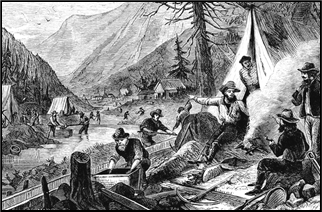 xxxxxAs we have seen, the Gold Rushes of “modern times”
began with the discovery of gold in the foothills of the Sierra
Nevada in central California in 1848
(Va). Within a matter of months
thousands of fortune hunters had arrived in the area, living rough
in tents and primitive shacks. Over the next twelve years or so
this discovery sparked off a spate of finds across the globe. Gold
was struck around the towns of Ballarat and Bendigo in southern
Australia; just north of the present day city of Johannesburg in South Africa; along the lower
Fraser River and at Cariboo in British Columbia; and in parts of
the South Island of New Zealand.
xxxxxAs we have seen, the Gold Rushes of “modern times”
began with the discovery of gold in the foothills of the Sierra
Nevada in central California in 1848
(Va). Within a matter of months
thousands of fortune hunters had arrived in the area, living rough
in tents and primitive shacks. Over the next twelve years or so
this discovery sparked off a spate of finds across the globe. Gold
was struck around the towns of Ballarat and Bendigo in southern
Australia; just north of the present day city of Johannesburg in South Africa; along the lower
Fraser River and at Cariboo in British Columbia; and in parts of
the South Island of New Zealand.
xxxxxBy the
early 1860s, the most accessible gold deposits in these regions -
xxxxxWithin a
matter of months, as one would expect, a fresh swarm of fortune
seekers had arrived in the region from all parts of the world,
including Cornish and Welsh miners from Britain, and prospectors
from across Australia and California. A shanty town of some 3,000
people was soon up and running on the bare Veld, clustered around
Ferreira’s Camp. It was first named Randjeslaagte, but within a
few years this sprawling settlement came to be known as
Johannesburg, one of the last great boomtowns of the 19th century.
In the space of ten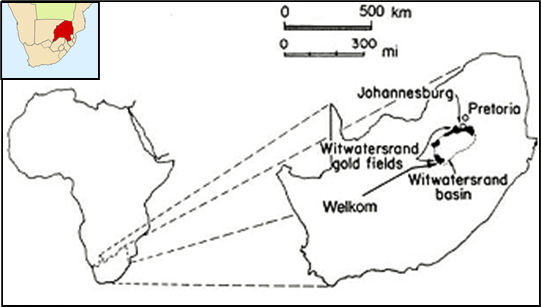 years it was bigger than Cape Town, and within a hundred years it
was one of the largest cities in the world. Unlike most of the
finds in North America and Australia, the goldfields of the
Witwatersrand remained productive, stretching in a “golden arc”
from Johannesburg to Welkom, some 140 miles to the south-
years it was bigger than Cape Town, and within a hundred years it
was one of the largest cities in the world. Unlike most of the
finds in North America and Australia, the goldfields of the
Witwatersrand remained productive, stretching in a “golden arc”
from Johannesburg to Welkom, some 140 miles to the south-
xxxxxAs we shall
see, the Witwatersrand Gold Rush played a major part in the ill-
xxxxxIncidentally, George Harrison (an Australian or perhaps an Englishman who had panned for gold in Australia) never realised the importance of his find. He sold his claim for under £10 and left the area. He was never seen or heard of again. However, a monument was placed where it is thought he made his find, and a park in Johannesburg is named after him. ……
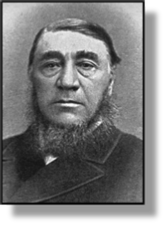 xxxxx…… How the city of
Johannesburg came by its name remains unclear. The general view is
that it was named after the two-
xxxxx…… How the city of
Johannesburg came by its name remains unclear. The general view is
that it was named after the two-
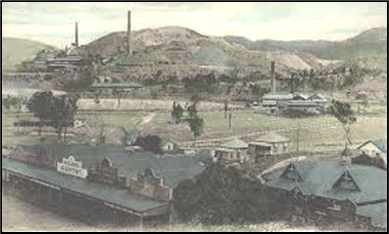
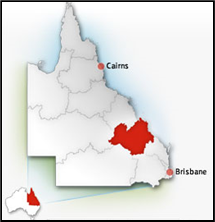 xxxxxIn the meantime gold fever returned to Australia.
Following the finds in Victoria in the 1850s, gold was discovered
in Queensland,
starting with the Canoona Gold Rush of 1858, spreading to areas
around Peak Downs, Gympie, Charters Towers and Palmer River, and
culminating in the opening of the vast goldfield at Mount Morgan (illustrated) in 1882. By the
time that mine was closed in 1981 most of the mountain had been
removed, and some 260 tonnes of gold had been produced -
xxxxxIn the meantime gold fever returned to Australia.
Following the finds in Victoria in the 1850s, gold was discovered
in Queensland,
starting with the Canoona Gold Rush of 1858, spreading to areas
around Peak Downs, Gympie, Charters Towers and Palmer River, and
culminating in the opening of the vast goldfield at Mount Morgan (illustrated) in 1882. By the
time that mine was closed in 1981 most of the mountain had been
removed, and some 260 tonnes of gold had been produced -
xxxxxAround this time, traces of gold were also found in the Northern Territory in the Pine Creek area south of Darwin. Small workings developed in a number of locations, including Tumbling Waters, Yam Creek and Gandy’s Gully, and two mines on the Eleanor Reef proved particularly valuable in the 1890s, but by the end of the century there was a general, irreversible decline in production, and the mining of tin and wolfram became more profitable.
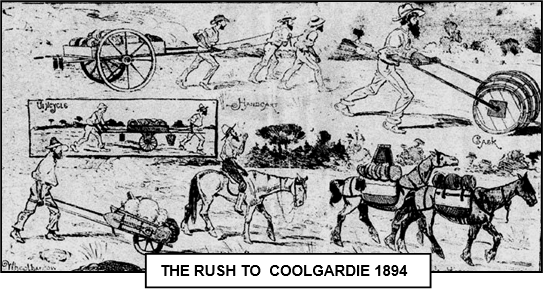 xxxxxIn the 1890s it was the turn of Western
Australia to become the new centre of
gold fever, brought about by the discovery of substantial fields
around Coolgardie and Kalgoorlie. In 1892 two prospectors named
Arthur Bayley and William Ford discovered over 500 ounces of gold
near Fly Flat, some 120 miles east of Southern Cross. Once they
had staked their claim the biggest gold rush in Australian history
was under wa
xxxxxIn the 1890s it was the turn of Western
Australia to become the new centre of
gold fever, brought about by the discovery of substantial fields
around Coolgardie and Kalgoorlie. In 1892 two prospectors named
Arthur Bayley and William Ford discovered over 500 ounces of gold
near Fly Flat, some 120 miles east of Southern Cross. Once they
had staked their claim the biggest gold rush in Australian history
was under wa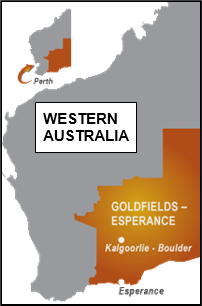 y.
Coolgardie was declared a town site in 1893, and by 1898 it was
the third largest town in Western Australia with a population of
over 16,000. However, by the end of the century the gold had begun
to run out, and within ten years the town was in serious decline.
By that time many diggers had moved to the much larger and more
prosperous field at Kalgoorlie, 25 miles further east. Gold in
that area had been discovered in a gully near Mount Charotte by an
Irishman named Patrick Hannan in June 1893. Accompanied by two
fellow Irishmen, he had stumbled, in fact, upon the largest open-
y.
Coolgardie was declared a town site in 1893, and by 1898 it was
the third largest town in Western Australia with a population of
over 16,000. However, by the end of the century the gold had begun
to run out, and within ten years the town was in serious decline.
By that time many diggers had moved to the much larger and more
prosperous field at Kalgoorlie, 25 miles further east. Gold in
that area had been discovered in a gully near Mount Charotte by an
Irishman named Patrick Hannan in June 1893. Accompanied by two
fellow Irishmen, he had stumbled, in fact, upon the largest open-
xxxxxAs a result
of these substantial finds, the economy of Western Australia
received an enormous boost, but for many of the miners there was
only hardship, sickness and death. While a few struck it rich, the
vast majority found nothing of value and lived in abject poverty.
The price of food -
Damn Coolgardie! Damn the track,
Damn it there and damn it back!
Damn the country, damn the weather,
Damn the goldfields altogether!
xxxxxIncidentally, in the late 1890s the value of Coolgardie and Kalgoorlie was such that they were used as a bargaining counter to force Western Australia to join the Australian federation. To make sure that the government in Perth held a referendum on federation, it was proposed that a new state called “Auralia” be set up around these two goldfields. As a result, Western Australia promptly agreed to the referendum and joined the federation in 1901! ……
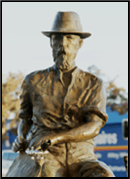
xxxxx…… The main street of Coolgardie is named after Arthur Bayley, and the main street and a suburb of Kalgoorlie are named after Paddy Hannan. And a statue of the Irishman was erected in the town in 1929 (illustrated) ……
xxxxx…… And it was in Western Australia in 1894 that gold was discovered near the town of Dundas. A prospector named Laurie Sinclair was camping in the area when his horse Norseman, pawing the ground, uncovered a gold nugget. When miners began to flock to the site, the government authorised the establishment of a town and, not surprisingly, it was named Norseman.
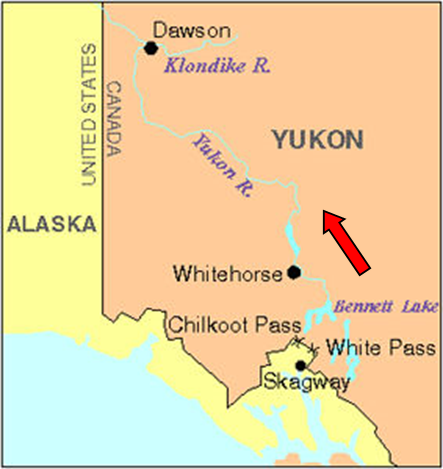 xxxxxBut the hardship suffered by the gold seekers in
South Africa and Australia was nothing compared with the suffering
endured by those who took part in the Klondike
Gold Rush in the Yukon area of Canada
towards the end of 1897. Rich deposits of gold had been discovered
in the area a year earlier when a Californian prospector named
George Washington Carmack and members of his family were fishing
for salmon in Rabbit Creek (later renamed Bonanza Creek), a
tributary of the Klondike River. Local miners quickly made
themselves a fortune and, on returning to San Francisco and
Seattle, their recently acquired wealth caused a frenzied
“stampede”. With little if any knowledge of the journey they were
about to undertake, it is estimated that 100,000 would-
xxxxxBut the hardship suffered by the gold seekers in
South Africa and Australia was nothing compared with the suffering
endured by those who took part in the Klondike
Gold Rush in the Yukon area of Canada
towards the end of 1897. Rich deposits of gold had been discovered
in the area a year earlier when a Californian prospector named
George Washington Carmack and members of his family were fishing
for salmon in Rabbit Creek (later renamed Bonanza Creek), a
tributary of the Klondike River. Local miners quickly made
themselves a fortune and, on returning to San Francisco and
Seattle, their recently acquired wealth caused a frenzied
“stampede”. With little if any knowledge of the journey they were
about to undertake, it is estimated that 100,000 would-
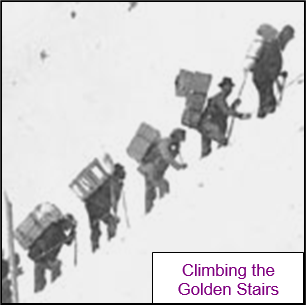
xxxxxSome of the
gold seekers, laden down with equipment and food supplies, took
the long gruelling overland route by way of British Columbia or
Edmonton -
xxxxxBut the
Klondike boon only lasted a few years. The readily accessible
mines were soon exhausted, and large companies then moved in,
using hydraulic and dredging methods to extract not only gold but
also silver, lead, zinc and copper. By 1900 many of the miners had
given up and returned home, while some -
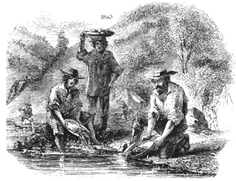 xxxxxBy the turn of the century this latest spate of gold
rushes was virtually over. Of the thousands that went in search of
a fortune very few struck it rich, and in many cases the hardship
they suffered was immense. However, these stampedes had a major
effect upon the economy of the areas in which they took place.
Johannesburg owed its existence to the Witwatersrand gold rush in the
Transvaal, both Queensland and Western Australia gained by the
interest their finds attracted, and the remote areas in
particular, Alaska and the north-
xxxxxBy the turn of the century this latest spate of gold
rushes was virtually over. Of the thousands that went in search of
a fortune very few struck it rich, and in many cases the hardship
they suffered was immense. However, these stampedes had a major
effect upon the economy of the areas in which they took place.
Johannesburg owed its existence to the Witwatersrand gold rush in the
Transvaal, both Queensland and Western Australia gained by the
interest their finds attracted, and the remote areas in
particular, Alaska and the north-
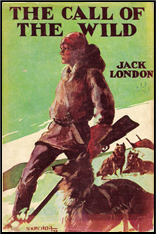
xxxxxIncidentally, amongxthose who joined in
the Klondike Gold Rush was William Howard Taft -
Vc-
Including:
Queensland,
Western Australia,
Klondike, Yukon,
and Anvil Creek, Alaska



